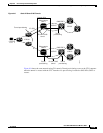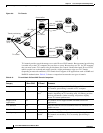
8-20
Cisco ONS 15454 Reference Manual, R8.5.x
78-18106-01
Chapter 8 Cisco Transport Controller Operation
8.7 Using the CTC Launcher Application to Manage Multiple ONS Nodes
Figure 8-9 TL1 Tunnels
TL1 tunnels provide several advantages over static IP-over-CLNS tunnels. Because tunnel provisioning
is needed only at the CTC computer, they are faster to set up. Because they use TL1 for TCP transport,
they are more secure. TL1 tunnels also provide better flow control. On the other hand, IP over CLNS
tunnels require less overhead and usually provide a slight performance edge over TL1 Tunnels
(depending on network conditions). TL1 tunnels do not support all IP applications such as SNMP and
RADIUS Authentication. Table 8-13 shows a comparison between the two types of tunnels.
Other vendor
GNE 1
Other vendor
GNE 2
Central office
IP + OSI
TL1 tunnel
IP
OSI/DCC
OSI/DCC
IP/DCC
IP/DCC
Tunnel provisioning
140175
IP DCN
CTC
ONS ENE 1
ONS ENE 2
TL1 tunnel
Table 8-13 TL1 and Static IP-Over-CLNS Tunnels Comparison
Category
Static
IP-Over-CLNS TL1 Tunnel Comments
Setup Complex Simple Requires provisioning at ONS NE, GNE, and DCN routers. For
TL1 tunnels, provisioning is needed at CTC computer.
Performance Best Average to
good
Static tunnels generally provide better performance than TL1
tunnels, depending on TL1 encoding used. LV+Binary provides
the best performance. Other encoding will produce slightly
slower TL1 tunnel performance.
Support all IP
applications
Yes No TL1 tunnels do not support SNMP or RADIUS Server IP
applications.
ITU Standard Yes No Only the static IP-over-CLNS tunnels meet ITU standards. TL1
tunnels are new.
Tunnel traffic control Good Very good Both tunnel types provide good traffic control
Security setup Complex No setup
needed
Static IP-over-CLNS tunnels require careful planning. Because
TL1 tunnels are carried by TL1, no security provisioning is
needed.


















